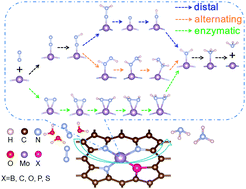Boosting electrochemical nitrogen reduction reaction performance of two-dimensional Mo porphyrin monolayers via turning the coordination environment†
Abstract
Designing atomically dispersed metal catalysts for the nitrogen reduction reaction (NRR) is an effective approach to achieve better energy conversion efficiencies. In this study, we designed a series of single molybdenum (Mo) atom-anchored porous two-dimensional Mo porphyrin (2D Mo-Pp) monolayers modified by B, C, O, P and S as efficient NRR catalysts to improve the catalytic performance. We introduced two key parameters, θ (pz orbital filling of heteroatoms) and φ (Bader charge of central Mo atoms). It shows that θ and φ play important roles in nitrogen absorption by analyzing the regression models. In particular, the theoretical results suggested that the 2D Mo-Pp monolayer modified by B has an ultralow limiting potential of 0.35 V and can suppress the hydrogen evolution reaction, making the 2D Mo-Pp monolayer modified by B a promising NRR electrocatalyst with high efficiency and selectivity. This work provides insights into the rational design of the elaborate structure of single-atom catalysts with tunable electrocatalytic activities.



 Please wait while we load your content...
Please wait while we load your content...